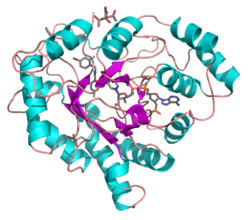Aldose reductase
| Aldose reductase | ||
|---|---|---|

|
||
| Ribbon model of human aldose reductase, with NADP, citrate and an inhibitor as rods, according to PDB 1US0 | ||
|
Existing structural data: s. UniProt |
||
| Properties of human protein | ||
| Mass / length primary structure | 315 amino acids | |
| Secondary to quaternary structure | Monomer | |
| Identifier | ||
| Gene name | AKR1B1 | |
| External IDs | ||
| Enzyme classification | ||
| EC, category | 1.1.1.21 , oxidoreductase | |
| Response type | Redox reaction | |
| Substrate | Alditol + NAD (P) + | |
| Products | Aldose + NAD (P) H / H + | |
| Occurrence | ||
| Parent taxon | Creature | |
Aldose reductase (AR) ( gene : AKR1B1 ) is an enzyme that catalyzes the reduction of various aldehydes and ketones (including monosaccharides ). Aldose reductase is particularly known for converting glucose into sorbitol . This is the first step in the polyol pathway used by cells to produce fructose from glucose without consuming ATP . The most important task of AR is probably to reduce toxic aldehydes that are produced in the metabolism . Every living being uses AR. The human adrenal glands produce the most AR, but it is active in all tissue types.
In diabetes mellitus or galactosemia , AR produces a lot of sorbitol, which, due to the slowness of sorbitol dehydrogenase, accumulates in the cells and causes damage in the kidneys, eyes and nerves in particular due to the high osmotic pressure. In order to alleviate the sequelae of diabetes, attempts are therefore being made to find drugs that inhibit AR. A first marketing attempt with Tolrestat had to be withdrawn in 1997 because of severe liver toxicity. The best-studied possible drugs are currently Epalrestat and Ranirestat . Epalrestat has received approval in Japan.
In addition to its function in sugar metabolism and in the detoxification of aldehydes, AR also plays a role in signal transduction during inflammatory processes.
Reactions
D -galactose is the aldose reductase with NADPH as cofactor to galactitol implemented.
Web links
Individual evidence
- ↑ UniProt P15121 .
- ↑ a b aldose reductase. In: Online Mendelian Inheritance in Man . (English).
- ↑ Ramirez MA, Borja NL: Epalrestat: an aldose reductase inhibitor for the treatment of diabetic neuropathy . In: Pharmacotherapy . 28, No. 5, May 2008, pp. 646-655. doi : 10.1592 / phco.28.5.646 . PMID 18447661 .
- ↑ Giannoukakis N: Ranirestat as a therapeutic aldose reductase inhibitor for diabetic complications . In: Expert Opin Investig Drugs . 17, No. 4, April 2008, pp. 575-581. doi : 10.1517 / 13543784.17.4.575 . PMID 18363521 .
- ↑ El-Kabbani O, Podjarny A: Selectivity determinants of the aldose and aldehyde reductase inhibitor-binding sites . In: Cell. Mol. Life Sci. . 64, No. 15, August 2007, pp. 1970-1978. doi : 10.1007 / s00018-007-6514-3 . PMID 17497245 .
- ^ A. Corso, M. Cappiello, U. Mura: From a Dull Enzyme to Something Else: Facts and Perspectives Regarding Aldose Reductase . In: Current Medicinal Chemistry . tape 15 , no. 15 , 2008, p. 1452-1461 , doi : 10.2174 / 092986708784638870 , PMID 18537622 .
- ↑ Jeremy M. Berg, John L. Tymoczko, Lubert Stryer, Gregory J. Gatto, Jr.: Stryer Biochemistry . Springer-Verlag, 2014, ISBN 978-3-8274-2988-9 , pp. 476 ( limited preview in Google Book search).



